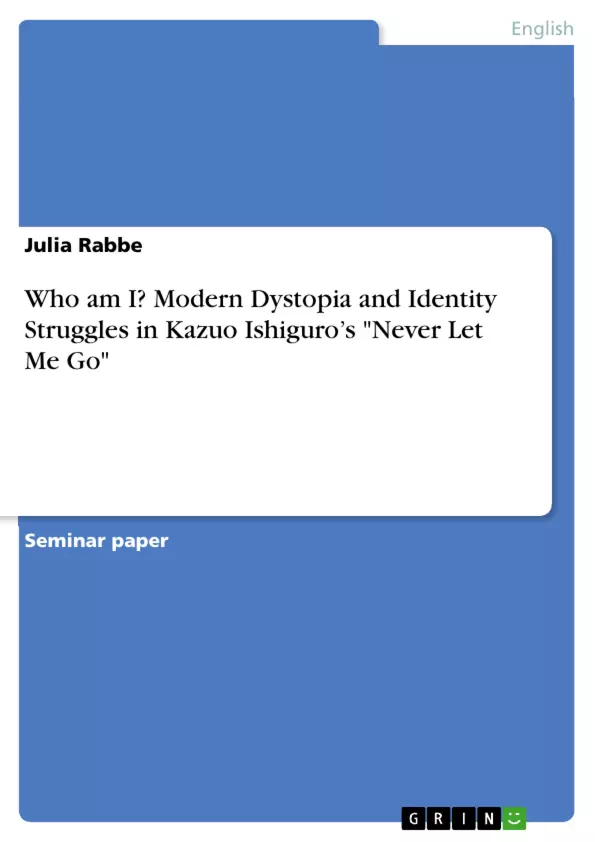Who am I? This is a question we frequently ask ourselves, which is not easy to answer. Human beings naturally try to answer the identity question and it is one of the essential processes of growing up. But if we imagine ourselves living in a world in which one’s whole life is predestined and it is impossible to escape from this destiny, it seems impossible to answer such a question.
The dystopian novel “Never Let Me Go” by Kazuo Ishiguro is set at a boarding school in England at the end of the twentieth century. The protagonists in the novel, who are growing up at the boarding school Hailsham, face the above-described problem. They are brought up healthy and kept away from every danger possible, to live the life they are supposed to live. They finish school, move in groups to farms where they have to work, they become carers temporarily, until they end up becoming donors of their vital organs. Around the time they have done their third or fourth donation, their short life will be completed. This leads to a struggle of finding identity and to the question, what identity really is.
In this term paper, the question of how the characters deal with the predestination of their lives will be answered. It will be discussed, in which ways they try to build up an identity, even though they face some problems. The central thesis, therefore, is that the social groups the protagonists live in and identify themselves with, make an important contribution to the formation of their identity and the process of finding belonging.
Inhaltsverzeichnis (Table of Contents)
- INTRODUCTION
- THE SOCIAL IDENTITY THEORY
- USE OF SPECIFIC TERMINOLOGY
- SOCIAL IDENTITY IN NEVER LET ME GO
- SOCIALIZATION AT HAILSHAM
- CATEGORIZATION AND SHIFTING GROUPS AT THE COTTAGES
- REDEFINITION OF GROUPS AFTER THE COTTAGES
- CONCLUSION
- BIBLIOGRAPHY
Zielsetzung und Themenschwerpunkte (Objectives and Key Themes)
This term paper explores the question of how characters in Kazuo Ishiguro's Never Let Me Go cope with the predetermined nature of their lives. It examines how they attempt to construct identities despite facing limitations. The central thesis argues that the social groups the protagonists inhabit and identify with significantly contribute to their identity formation and sense of belonging.
- The influence of social identity on individual identity formation
- The impact of social groups on a sense of belonging
- The role of socialization in shaping identity
- The complexities of identity in a dystopian setting
- The struggle for self-definition in the face of predetermined destinies
Zusammenfassung der Kapitel (Chapter Summaries)
The introduction provides a contextual overview of the novel's premise, highlighting the central theme of identity within a dystopian framework. The protagonists, raised in a boarding school called Hailsham, navigate a world where their lives are predetermined for organ donation. This chapter establishes the setting and introduces the key questions explored throughout the paper.
Chapter 2 delves into the Social Identity Theory by Henri Tajfel, offering a theoretical framework for understanding how social groups shape individual identity. Tajfel's concepts of categorization, in-group, and out-group are introduced and applied to the context of the novel.
Chapter 3 examines the language Ishiguro uses to depict the unique societal structure of the clones' world. This analysis aims to establish the relationship between social order and the formation of identity, laying the groundwork for the subsequent analysis of the novel.
Chapter 4 explores several excerpts from the novel that exemplify the identity struggles faced by the protagonists. Through a theoretical lens, the analysis reveals how the characters' membership in various social groups influences their identity development and the course of their lives.
Schlüsselwörter (Keywords)
This term paper focuses on the key concepts of identity, social identity, socialization, and group membership in the context of Kazuo Ishiguro's dystopian novel Never Let Me Go. The analysis draws heavily on the Social Identity Theory, employing its key principles to illuminate the relationship between social structures and individual identity formation in the unique setting of the novel.
- Quote paper
- Julia Rabbe (Author), 2018, Who am I? Modern Dystopia and Identity Struggles in Kazuo Ishiguro’s "Never Let Me Go", Munich, GRIN Verlag, https://www.grin.com/document/540170




